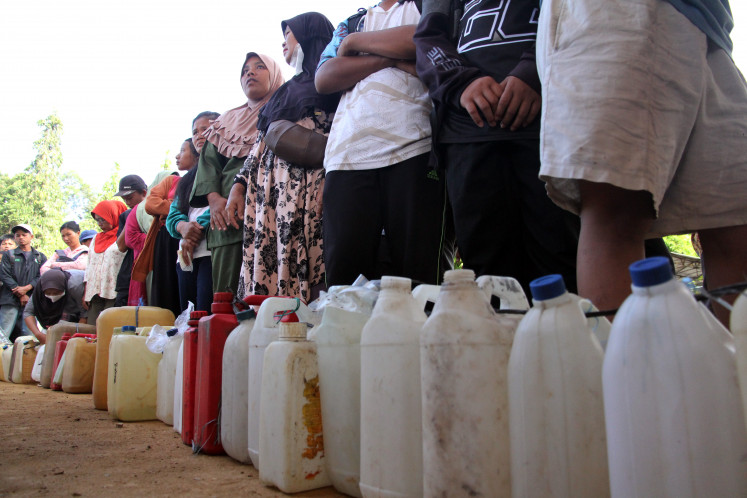Popular Reads
Top Results
Can't find what you're looking for?
View all search resultsPopular Reads
Top Results
Can't find what you're looking for?
View all search resultsWarehousing business grows but delivery problems linger
Port of call: Unloading goods at Samudera Port, part of the Samudera Indonesia Group
Change text size
Gift Premium Articles
to Anyone
![Port of call: Unloading goods at Samudera Port, part of the Samudera Indonesia Group. (Courtesy of Samudera Indonesia)" border="0" height="324" width="512"><span class="caption"><strong>Port of call: </strong>Unloading goods at Samudera Port, part of the Samudera Indonesia Group. (Courtesy of Samudera Indonesia)</span></span></p><p>Despite the growing trend in modern warehousing, the conventional way of handling warehousing is still common on account of rate considerations, with high logistics costs remaining a major issue.</p><p>Warehousing has become increasingly modern and sophisticated, with many providers applying more advanced IT in their warehouse management, although non-IT problems that hamper the delivery of goods, such as traffic jams, thugs and a lack of adequate ports, still linger.<br><br>Today, contemporary warehouses, the key to the supply chain, function as more than just goods-storage facilities. Warehousing companies are transforming themselves into âthird-party logistics providersâ (3PLs) that provide a wide array of services and functions. <br><br>In addition to packing and staging pallets, contemporary warehousing facilities offer light manufacturing, call centers, labeling and other non-storage options.<br><br>âThere is rising demand for modern warehousing. The demand comes from logistics firms, distribution and trading, etc.,â an industry source, who preferred to remain anonymous, said.<br><br>The use of more advanced technology in warehouse management, such as through the implementation of the Internet-enabled warehouse management system (WMS), has gained ground. <br><br>âThe number of companies that use advanced technology such as barcoding, ASRS [automatic store and retrieval system], cross-docking, WMS, vendor-managed inventory and efficient consumer response [ECR] is on the increase,â said Rachmat Noviandi, a consultant, trainer and speaker on warehousing management and logistics.</p><p> âThe increase is logically understood because todayâs customers need fast, accurate and safe delivery of goods.â<br>Before being transported to distribution points like hypermarkets, supermarkets, shops or warung (traditional shops), the finished products should first be stored in a warehouse, depending on the nature of the products. For goods that easily decay like food or medicine, they should be stored in a refrigerated warehouse at a cool temperature or in cold storage. <br><br>Only advanced industries have equipped themselves with their own warehouses. Because of cost considerations, many companies outsource their warehousing activities to professional companies. <br><br>Goenawan Loekito, a coach and specialist in business and leadership issues, was of the view that more logistics operators have adopted IT-based systems, underlining the importance of understanding the specific business a company runs as this would have an impact on business processes that customers implement. <br><br>âEven though a commonly found pattern of warehousing is incoming, finished and stored and outgoing products, when the products become more specific in terms of kind, size and incoming and outgoing volume, this will determine IT systems that the company should apply,â he noted. <br><br>âThe business process will decide what IT is suitable for it to use, such as the application of barcodes; the tools applied to warehouses storing heavy equipment, for instance, are different from those used in good product-storing warehouses in terms of the application of barcodes.â <br><br>He also remarks that more warehouse providers now understood this.<br><br>Meanwhile, Ivan Christian, a logistics company practitioner, disclosed the great benefit of the use of IT in his company and said it would be continually improved. <br><br>âFor example, under the IT system, IT-enabled customers are directly connected to our logistics company when placing an order and the order can be received by a third party in real time. This means time efficiency in operational process and ensures that product data that has to be processed by the third party is in accordance with the request by customers,â he explained, adding that billing management and dashboard management could also take advantage of the use of IT systems. <br><br><strong>High logistics costs</strong><br><br>According to Bani M. Mulia, managing director of logistics company PT Samudera Indonesia Tangguh, modern warehousing is not just about having a good appearance but âhow it will give added value to customersâ. <br><br>âThatâs why besides storing goods, our integrated logistics company also offers other services such as packaging, consolidated export/import, etc. and so, it is increasingly customized, depending on what customers want.â<br><br>âInterested customers can also take advantage of our tracking system in which they can track, check and monitor their goods in different cities from their office.â<br><br>But due to lingering price disparity, the modern way of handling warehousing or distribution centers is commonly targeted to premium products and theconventional way in this regard is still frequently utilized, especially by rate-conscious firms.<br><br>âAs Pak [President Joko] âJokowiâ [Widodo] has said, the price of cement in Java is different [much lower] than in Papua. The conventional way of handling is used because using modern and sophisticated ways in the ports is still expensive because the ports in Indonesia have yet to be efficient, with preman [thugs] who ask for money remaining on the rampage,â he said, adding that the important thing then was products reaching their destination in a good state.<br><br>Specialists in business issues, practitioners and operators are of the view that despite the lingering problems facing logistics operators, including under-the-table practices, traffic jams and extra funds that logistics operators spend on paying preman and illegal levies, Indonesia is witnessing a growing logistics business, including warehousing. </p><p><span class="inline inline-center"><img class="image image-_original " src="http://202.158.21.182/files/images2/p17put.jpg" alt="Put it in place: In meeting the needs of todayâs market, Samudera Logistics implements modern warehousing. (Courtesy of Samudera Indonesia)" title="Put it in place: In meeting the needs of todayâs market, Samudera Logistics implements modern warehousing. (Courtesy of Samudera Indonesia)](https://www.thejakartapost.com/files/images2/p17portof.jpg) Port of call: Unloading goods at Samudera Port, part of the Samudera Indonesia Group. (Courtesy of Samudera Indonesia)" border="0" height="324" width="512">Port of call: Unloading goods at Samudera Port, part of the Samudera Indonesia Group. (Courtesy of Samudera Indonesia)
Port of call: Unloading goods at Samudera Port, part of the Samudera Indonesia Group. (Courtesy of Samudera Indonesia)" border="0" height="324" width="512">Port of call: Unloading goods at Samudera Port, part of the Samudera Indonesia Group. (Courtesy of Samudera Indonesia)Despite the growing trend in modern warehousing, the conventional way of handling warehousing is still common on account of rate considerations, with high logistics costs remaining a major issue.
Warehousing has become increasingly modern and sophisticated, with many providers applying more advanced IT in their warehouse management, although non-IT problems that hamper the delivery of goods, such as traffic jams, thugs and a lack of adequate ports, still linger.
Today, contemporary warehouses, the key to the supply chain, function as more than just goods-storage facilities. Warehousing companies are transforming themselves into âthird-party logistics providersâ (3PLs) that provide a wide array of services and functions.
In addition to packing and staging pallets, contemporary warehousing facilities offer light manufacturing, call centers, labeling and other non-storage options.
âThere is rising demand for modern warehousing. The demand comes from logistics firms, distribution and trading, etc.,â an industry source, who preferred to remain anonymous, said.
The use of more advanced technology in warehouse management, such as through the implementation of the Internet-enabled warehouse management system (WMS), has gained ground.
âThe number of companies that use advanced technology such as barcoding, ASRS [automatic store and retrieval system], cross-docking, WMS, vendor-managed inventory and efficient consumer response [ECR] is on the increase,â said Rachmat Noviandi, a consultant, trainer and speaker on warehousing management and logistics.
âThe increase is logically understood because todayâs customers need fast, accurate and safe delivery of goods.â
Before being transported to distribution points like hypermarkets, supermarkets, shops or warung (traditional shops), the finished products should first be stored in a warehouse, depending on the nature of the products. For goods that easily decay like food or medicine, they should be stored in a refrigerated warehouse at a cool temperature or in cold storage.
Only advanced industries have equipped themselves with their own warehouses. Because of cost considerations, many companies outsource their warehousing activities to professional companies.
Goenawan Loekito, a coach and specialist in business and leadership issues, was of the view that more logistics operators have adopted IT-based systems, underlining the importance of understanding the specific business a company runs as this would have an impact on business processes that customers implement.
âEven though a commonly found pattern of warehousing is incoming, finished and stored and outgoing products, when the products become more specific in terms of kind, size and incoming and outgoing volume, this will determine IT systems that the company should apply,â he noted.
âThe business process will decide what IT is suitable for it to use, such as the application of barcodes; the tools applied to warehouses storing heavy equipment, for instance, are different from those used in good product-storing warehouses in terms of the application of barcodes.â
He also remarks that more warehouse providers now understood this.
Meanwhile, Ivan Christian, a logistics company practitioner, disclosed the great benefit of the use of IT in his company and said it would be continually improved.
âFor example, under the IT system, IT-enabled customers are directly connected to our logistics company when placing an order and the order can be received by a third party in real time. This means time efficiency in operational process and ensures that product data that has to be processed by the third party is in accordance with the request by customers,â he explained, adding that billing management and dashboard management could also take advantage of the use of IT systems.
High logistics costs
According to Bani M. Mulia, managing director of logistics company PT Samudera Indonesia Tangguh, modern warehousing is not just about having a good appearance but âhow it will give added value to customersâ.
âThatâs why besides storing goods, our integrated logistics company also offers other services such as packaging, consolidated export/import, etc. and so, it is increasingly customized, depending on what customers want.â
âInterested customers can also take advantage of our tracking system in which they can track, check and monitor their goods in different cities from their office.â
But due to lingering price disparity, the modern way of handling warehousing or distribution centers is commonly targeted to premium products and theconventional way in this regard is still frequently utilized, especially by rate-conscious firms.
âAs Pak [President Joko] âJokowiâ [Widodo] has said, the price of cement in Java is different [much lower] than in Papua. The conventional way of handling is used because using modern and sophisticated ways in the ports is still expensive because the ports in Indonesia have yet to be efficient, with preman [thugs] who ask for money remaining on the rampage,â he said, adding that the important thing then was products reaching their destination in a good state.
Specialists in business issues, practitioners and operators are of the view that despite the lingering problems facing logistics operators, including under-the-table practices, traffic jams and extra funds that logistics operators spend on paying preman and illegal levies, Indonesia is witnessing a growing logistics business, including warehousing.
 Port of call: <)
Port of call: <)
Port of call: Unloading goods at Samudera Port, part of the Samudera Indonesia Group. (Courtesy of Samudera Indonesia)
Despite the growing trend in modern warehousing, the conventional way of handling warehousing is still common on account of rate considerations, with high logistics costs remaining a major issue.
Warehousing has become increasingly modern and sophisticated, with many providers applying more advanced IT in their warehouse management, although non-IT problems that hamper the delivery of goods, such as traffic jams, thugs and a lack of adequate ports, still linger.
Today, contemporary warehouses, the key to the supply chain, function as more than just goods-storage facilities. Warehousing companies are transforming themselves into 'third-party logistics providers' (3PLs) that provide a wide array of services and functions.
In addition to packing and staging pallets, contemporary warehousing facilities offer light manufacturing, call centers, labeling and other non-storage options.
'There is rising demand for modern warehousing. The demand comes from logistics firms, distribution and trading, etc.,' an industry source, who preferred to remain anonymous, said.
The use of more advanced technology in warehouse management, such as through the implementation of the Internet-enabled warehouse management system (WMS), has gained ground.
'The number of companies that use advanced technology such as barcoding, ASRS [automatic store and retrieval system], cross-docking, WMS, vendor-managed inventory and efficient consumer response [ECR] is on the increase,' said Rachmat Noviandi, a consultant, trainer and speaker on warehousing management and logistics.
'The increase is logically understood because today's customers need fast, accurate and safe delivery of goods.'
Before being transported to distribution points like hypermarkets, supermarkets, shops or warung (traditional shops), the finished products should first be stored in a warehouse, depending on the nature of the products. For goods that easily decay like food or medicine, they should be stored in a refrigerated warehouse at a cool temperature or in cold storage.
Only advanced industries have equipped themselves with their own warehouses. Because of cost considerations, many companies outsource their warehousing activities to professional companies.
Goenawan Loekito, a coach and specialist in business and leadership issues, was of the view that more logistics operators have adopted IT-based systems, underlining the importance of understanding the specific business a company runs as this would have an impact on business processes that customers implement.
'Even though a commonly found pattern of warehousing is incoming, finished and stored and outgoing products, when the products become more specific in terms of kind, size and incoming and outgoing volume, this will determine IT systems that the company should apply,' he noted.
'The business process will decide what IT is suitable for it to use, such as the application of barcodes; the tools applied to warehouses storing heavy equipment, for instance, are different from those used in good product-storing warehouses in terms of the application of barcodes.'
He also remarks that more warehouse providers now understood this.
Meanwhile, Ivan Christian, a logistics company practitioner, disclosed the great benefit of the use of IT in his company and said it would be continually improved.
'For example, under the IT system, IT-enabled customers are directly connected to our logistics company when placing an order and the order can be received by a third party in real time. This means time efficiency in operational process and ensures that product data that has to be processed by the third party is in accordance with the request by customers,' he explained, adding that billing management and dashboard management could also take advantage of the use of IT systems.
High logistics costs
According to Bani M. Mulia, managing director of logistics company PT Samudera Indonesia Tangguh, modern warehousing is not just about having a good appearance but 'how it will give added value to customers'.
'That's why besides storing goods, our integrated logistics company also offers other services such as packaging, consolidated export/import, etc. and so, it is increasingly customized, depending on what customers want.'
'Interested customers can also take advantage of our tracking system in which they can track, check and monitor their goods in different cities from their office.'
But due to lingering price disparity, the modern way of handling warehousing or distribution centers is commonly targeted to premium products and theconventional way in this regard is still frequently utilized, especially by rate-conscious firms.
'As Pak [President Joko] 'Jokowi' [Widodo] has said, the price of cement in Java is different [much lower] than in Papua. The conventional way of handling is used because using modern and sophisticated ways in the ports is still expensive because the ports in Indonesia have yet to be efficient, with preman [thugs] who ask for money remaining on the rampage,' he said, adding that the important thing then was products reaching their destination in a good state.
Specialists in business issues, practitioners and operators are of the view that despite the lingering problems facing logistics operators, including under-the-table practices, traffic jams and extra funds that logistics operators spend on paying preman and illegal levies, Indonesia is witnessing a growing logistics business, including warehousing.
Put it in place: In meeting the needs of today's market, Samudera Logistics implements modern warehousing. (Courtesy of Samudera Indonesia)
It is common knowledge that delivery of goods to a warehouse from a manufacturing company or to a seaport or airport and vice versa is frequently obstructed by chronic traffic jams, which is another contributing factor to high logistics costs, according to specialists and practitioners.
Goenawan said that coaching preman by unearthing their potential could be an alternative solution to the preman-related problem. 'We have to embrace and engage them and touch their hearts to make them aware of their wrongdoings.'
The warehousing business would keep thriving as long as industries continue to grow and 'in Indonesia, a variety of products from different industries, ranging from fast-moving consumer goods to heavy equipment, is growing,' said Goenawan.
Thanks to the thriving industry of different products and a climate conducive to investment under the new administration, warehouse storage facilities have increasingly mushroomed in the Greater Jakarta area (Jakarta, Bogor, Depok, Tangerang and Bekasi). Advancement is also seen in the concept and design of warehouses.
The Cengkareng Business Center, BizPark Commercial Estate, Biz Hub Serpong, Duta Indah Karya, Marunda Center, Surya Kadu, The PRIME Sentra Niaga, Taman Tekno 8 and Woodland Bizhub Tambun, to name a few, are warehouse storage providers that recognize the surge in demand from companies, including multinational companies that have just entered Indonesian market.
Several developers have also aimed to reap profit from this lucrative logistics business. Developer PT Paramount Enterprise International is one example.
The developer has launched the Bezpark Commercial Center (BCC) in Balaraja, Tangerang, for example. BCC, built on some 13 hectares of land, is specially designed for industries whose production process does not cause harmful waste as 'keeping the environment free of waste and pollution is part of our business commitment,' said Dani Kurniawan of BCC.
'Our warehouse serves as an exhibition room, an office, a studio, a workshop, a distribution center, living space and home industry.'









